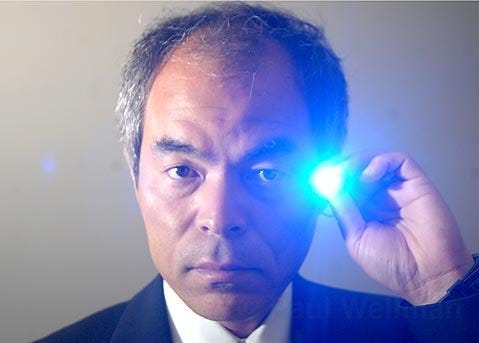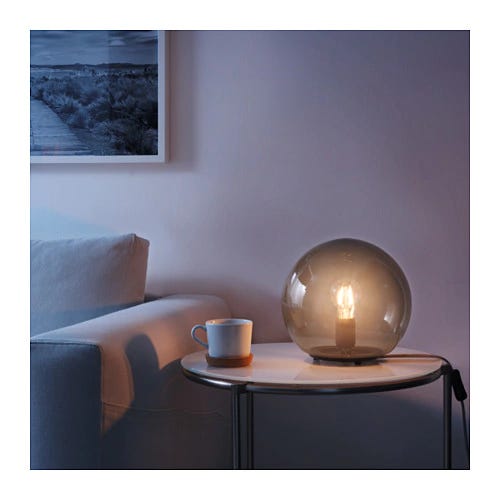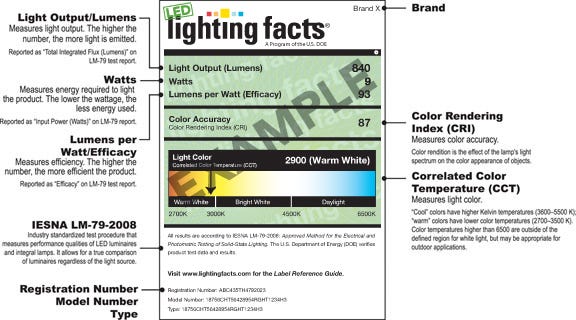
The Future of Light

Edison’s
commercialization of the electric light bulb quite literally changed
the world. His technology helped enable the power grid, modern
transportation, and ultimately the lifestyles we enjoy today. Lighting
improved gradually over the last century until the recent mass adoption
of LEDs.
As
LED lighting goes mainstream, we face new challenges. You can no longer
buy a 60 Watt bulb. Instead, you have to dive deep on CCT, CRI, lumens,
and other jargon. There is an increased awareness of the risks of blue
light coupled with unwarranted demonization of the new technology. The
lighting industry as a whole faces stagnation.
How do we get out of this mess, and where do we go from here?
The LED Revolution
Red
and green LEDs have been around for about 50 years, mostly confined to
use as indicator lights in electronics. In the early 90s, three Japanese
researchers at Nagoya University and Nichia Chemical created the first
blue light emitting diode (LED) from gallium nitride (GaN).

The
discovery by Nobel recipients Isamu Akasaki, Hiroshi Amano, and Shuji
Nakamura was significant because blue light can be converted to white
light by means of a phosphor material. The phosphor material, for
example yttrium aluminium garnet (YAG), is generally yellow in color and
sits atop the LED die material.
In
the mid-2000s, companies started packaging blue LEDs and phosphors into
bulbs and other light sources. These early products were expensive
($20-$50 for a bulb) and largely had problems with color consistency,
heat, and lifetime.
Today, you can buy an LED bulb for about $1.50.
The cost of components dropped, along with increases in performance. According to Haitz’s law, the cost per lumen (an amount of emitted light) decreases by a factor of 10 each decade.
Today, you can buy an LED bulb for about $1.50.
That bulb has better color performance than its swirly compact
fluorescent equivalent, and lasts 10,000–20,000 hours. Other LED sources
can last significantly longer (50,000–100,000 hours). By contrast, an
incandescent bulb may last 1,000–2,000 hours.
LED
lamps are not far off in price from incandescent lamps at the point of
sale. But their long lifetimes and low power usage mean you can save
significantly more. Over the life of a cheap LED bulb, you will pay
about $12, including the purchase price and energy. Five 60 Watt
incandescent bulbs would cost about $78 over the same period of time.
And don’t forget that you have to change the bulb five times instead of
just once.

Efforts have been made to phase out the sale of incandescent bulbs in numerous countries. Even though legislation has not passed in some places, the lighting industry has largely moved on to LED anyway. IKEA became the first large retailer to sell only LED lighting in 2015, and others are making similar moves.
The efforts are working. According to the U.S. Department of Energy, LED market penetration was 12.6% in 2016. That’s up from just 3% in 2014.
Massive Choice, Massive Confusion
All
is not well. LED had its moment of differentiation, but now it’s
largely a race to the bottom in price. That $1.50 bulb purchase will
happen one-fifth as often, breaking old business models. The old
stalwarts struggle to compete with new discount-oriented brands.
General Electric, the company Thomas Edison founded, plans to sell its bulb business due to low profit margins.
People just want their 60 Watt bulb back, energy savings be damned.
It’s
not even all that great for consumers. That LED bulb is cheap, but you
probably don’t really know what you’re getting. The Home Depot and other
retail outlets don’t do a good job of explaining color temperature
(CCT), lumens, and color rendering index (CRI). Manufacturers fuel the
confusion with misleading terms like “soft white” and “bright white.”
Early LED products were plagued with reliability issues and ugly color, further contributing to the stigma.
Oh, you want to use that bulb with your existing dimmer? Forget about it.
All
of this leads to mass dissatisfaction. And dissatisfaction results in
returns, which does not help the already low-margin consumer lighting
business. People just want their 60 Watt bulb back, energy savings be
damned.
Things
are a bit brighter in the commercial sector. LED fixtures are available
in a million shapes, sizes, and colors. Energy and maintenance costs
are drastically reduced, improving a building’s bottom line.
Most
commercial LED fixtures have no lamps to replace. They are intended to
last until the next renovation. Barring any electronics failures, LEDs
don’t “burn out.” They just get dimmer over time.

But the B2B sector also has its issues. Lighting controls are increasingly requested, and in some cases even required by law.
Very few manufacturers make all the components of a lighting system,
leading to incompatibilities. Even when the stars align, it can be
extremely costly and time-consuming to commission the system as
intended.
The DLC standard
focuses so much on energy efficiency that it may ultimately impair
quality of light. California, historically the most progressive state in
energy regulations, has fought back, putting a higher emphasis on color performance than energy. LEDs are efficient enough, they say. But the state is now under scrutiny for overriding federal energy efficiency regulations.
Blue Light Blues
At
the same time, we have become aware of the effects of light on the
human circadian rhythm. There’s debate about the nuances, but in
general, you can sleep better and perform better when there is
significant blue light during the day and very little at night.
In addition to the rods and cones, there is a third type
of photoreceptor in our eyes that is only sensitive to blue light.
Instead of contributing to vision, these cells tell the body clock when
it is daytime and when it is not.
This
mechanism worked well up until the last 150 years or so, before
electric lighting became ubiquitous. The same lighting found in our
homes and electronic devices can trick the body clock into thinking it’s
daytime when it is really not.
It’s not like the issue is limited to academics. People are aware of the effects of blue light, and want solutions.
Circadian
rhythm disruption may seem like a first world problem, less important
than public health issues related to malnutrition and poverty. But it
has been linked to breast cancer, Alzheimer’s disease,
and other conditions. Additionally, shift work and frequent time zone
hopping can contribute to accidents on and off the job, as well as
inconsistent menstrual cycles in females.
Apple is the only household name to have taken a significant stance on this problem, with the introduction of Night Shift
on iOS in early 2016 and on MacOS in 2017. Night Shift changes phone
and computer screens to an orange hue at night, reducing the blue light
content. Even then, the feature is not enabled by default and not widely
advertised by the company.
Anecdotally,
I was in an Apple Store recently. A little old lady came up to one of
the employees and asked how to get the orange light back on her phone.
It’s not like the issue is limited to academics. People are aware of the
effects of blue light, and want solutions.

The
lighting industry, in general, has made little progress in providing
straightforward products that address circadian disruption. The
specification community, which includes lighting designers and
architects, is begging for systems that support their latest
human-centric designs. But their pleas mostly fall on deaf ears.
The
industry’s arguments du jour against human-centric lighting circle
around: not enough research, disagreements on the spectrum of light, and
complexity of integrated systems. In my opinion, these are excuses to
avoid pioneering in an unverified market.
The
lighting giants are blind to the potential of human-centric lighting to
differentiate their businesses. There is room for someone to come in
and make a big splash.
Circadian Lighting
Several
upstarts have created a category that I call circadian lighting.
Broadly speaking, circadian lighting shifts in color and brightness
automatically throughout the day. The morning begins with a warm, dim
glow, giving way to cool, bright light during working hours. In the
evening, the lighting shifts back to a warm glow. It’s a lot like f.lux and Night Shift, but for your environment.
One of the most notable startups in this category is Ketra,
which makes a circadian lighting system that can be installed in the
home and commercial environments. It’s not particularly affordable, but
the Ketra system is the most complete and ready-to-go out of the box
circadian lighting solution at the moment.
Not
only does circadian lighting match the science, but it also just feels
right. Cool, relatively bright lighting during the day makes the indoor
environment seem more like outside. In the evening, dimmer, warmer light
promotes relaxation. Waking up in the middle of the night, only very
dim light is needed to guide the way. Otherwise, the light would
startle.

Ketra’s
offering is by far the most impressive, but there are signs of light
from other manufacturers. Philips offers an LED bulb for about $6
that can change between three color settings (dim and warm at night,
normal bright incandescent, and cool, bright white for the day) simply
by flicking a switch. IKEA has something similar but with wireless
remote controls and dimming for $27.
These
products can only be controlled manually, and thus are not true
circadian lighting. But they are something you can buy today for not a
lot of money to get a glimpse into the future.
Light Tuned to You
Circadian
lighting sounds great, but what about all the other factors that can
influence the circadian rhythm? What about food, social events,
caffeine, alcohol, stress, and travel?
A
lighting system is unlikely to counteract circadian disruption
completely. However, if it knows about your circadian state, the
lighting could help normalize the body’s cycle of sleep and wake.
The lighting in your environment would always be the right light for you.
Let’s
say you’re traveling to Tokyo in a week. Your destination is 13 hours
ahead of Eastern Daylight Time. Instead of throwing your circadian
rhythm into a complete 180 upon arrival, circadian lighting could help
you shift to the new time zone in the days leading up.
Or
you’re a shift worker on the night shift. But you also have weekend
activities planned with your family, most of which take place during the
day. Circadian lighting could help reduce the grogginess associated
with rapidly changing sleep patterns.

What
if the lighting in your home, car, office, and gym was tuned to your
circadian rhythm? What if the light at your desk was different from the
light at your neighbor’s desk? What about the lighting in your airplane
seat and the hotel room or Airbnb thousands of miles away?
What if the lighting system knows not only that someone is present in a room, but also who
that happens to be? The lighting in your environment would always be
the right light for you. You never would have to do much more than dim
the lights, and maybe not even that.
Building the Killer App
LED
lighting quickly moved from an expensive toy for early adopters to a
cheap commodity. Now there is room for a killer app, and I believe
advanced, connected circadian lighting is the answer.
A great product is simple, understandable, and affordable.
The pieces of the puzzle already exist to make all of this happen. A combination of GPS and an indoor positioning system can pinpoint your precise location anywhere in the world. Info about your sleep hygiene could come from a Fitbit or smartwatch. A phase response curve would be applied to shift your circadian rhythm by the amount appropriate at any given time.
Whoever
builds a circadian lighting solution will recognize that it is no easy
feat. It takes an understanding that a great product is simple,
understandable, and affordable. It takes the right people working toward
a uniform, opinionated vision.
We’ve
seen the potential of circadian lighting to positively impact people’s
lives. The awareness is there, and will continue to grow.
Now we’re just waiting for the right solution.

